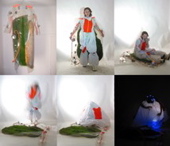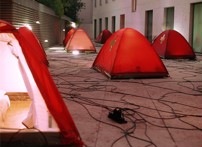(Originally published in Dédalo #02, Porto, March 07)
…
Until now, the idea of mobility in architecture has been mainly related to transit infrastructures or, on the other hand, to the very possibilities of architecture’s portability.
In the first case, architecture is essentially a program that echoes contemporary fluxes and logistics – thus mimetically or metaphorically offering a formal interpretation of such fluxes. Within a tradition of value expression – in which the modern architectural culture revelled – train stations, airports or other transport interfaces were characterised by a dynamic and fluid plasticity.
In the second case, architecture gets closer to industrial design and sees itself as portable, as capable of creating transportable, reproducible prototypes. Within this tendency, and during the 20th century, we can refer to a panoply of architectural research that extends from the pre-fabricated dwelling – that in the United States became in itself a mass-market of effectively transportable models – to the design of every type of container and movement units.
This panorama suggests an architecture that has moved beyond the realm of Vitruvean firmitas and a still prevailing notion of architectural permanence.
Architecture is thus also conceivable as a specialised practice that produces ephemeral ideas and concepts that may as well respond to an expanded notion of mobility within contemporary society. In fact, mobility is no longer only physical and related to infrastructural needs. It is also social, political, economical, or psychological.
As Alain Bourdin states in La Métropole des Individus, to be “permanently in movement” is today also to be able to “surf on the fluxes of fashion, atmospheres and events.” We confront ever-increasing changes in urban lifestyles and practices, we face faster turnovers of collective and individual identities, we are increasingly conscious of eminent ecological and social disasters that disrupt what was before stable and definitive.
Within such scenarios, architecture cannot escape the social and political responsibility of responding to problems arising from new forms of mobility. This was already the perception of the futurists in the 1920’s, albeit translated into a simplified and radical avant-garde response.
But the physical expressions of speed and destruction are no longer our main concerns. Whereas the ephemeral was, by the time of the futurists, an implicit result of war, today the ephemeral is a condition of consumption and technology.
In this new context, ephemeral architecture is rather to be seen as a critical answer to the mobility of values, ambiances and fast-changing needs. Architecture may thus evolve from the notion of a static service – traditionally related to the slowness of urban construction and identity transformations – to that of a performance, ie, a dynamic response to the accelerated needs of contemporary society.
In this particular sense of the word performance, though, architecture could be seen as merely obliged to a certain technical and economical efficiency. This would imply that architecture could lose a certain critical edge regarding the conditions of late modern society.
Thus, the notion of performance must also retain a cultural dimension.
Accepting architecture as cultural production, its performative dimension must also contribute to a critical role, that is, to architecture’s capacity to produce commentary regarding the ongoing transformations of culture and society.
In this sense, the notion of architectural performance implied here feeds directly upon the tradition of performance art.
As such, architecture as performance feeds on the historical tendency of performance art as a practice that, from the 70’s on, escapes the canons of the self-contained work of art to focus on the body, on the context and on the principle of action. The performative action becomes a radical social gesture that goes far beyond the production of an aesthetic object.
Considering such inheritance, it is no surprise, then, that the architectural interventions that we may today relate to this notion of performance often combine an artistic modus operandi with a deep sense of social responsibility.
This tendency was already at the crux of performance art – just consider, for example, how the by now universal problem of the homeless was being addressed very early on by Kryzstof Wodiczko. But, further than that, the notion of performance also reveals itself to be quite an efficient political tool for architecture to produce fast statements in an ever-changing urban environment.
 A project like Body Transit, by Paris-based Didier Fiuza Faustino, not only embodies an undeniable performative dimension, but it addresses also the political and social mobility of illegal immigrants in Europe. The logic of performance is also stressed here in the fact that, in the good tradition of performance art, it is the architect’s body itself that is represented inside Faustino’s ergonomic and embryonic architecture. Only then does the critical message acquire an accomplished meaning.
A project like Body Transit, by Paris-based Didier Fiuza Faustino, not only embodies an undeniable performative dimension, but it addresses also the political and social mobility of illegal immigrants in Europe. The logic of performance is also stressed here in the fact that, in the good tradition of performance art, it is the architect’s body itself that is represented inside Faustino’s ergonomic and embryonic architecture. Only then does the critical message acquire an accomplished meaning.
The same can be said of Stairway to Heaven, an object for a solitary sports performance, which is critical of its social surroundings and acquires its deep sense when some youngster pops up for its solitary basketball game.
 The first works of Diller & Scofidio display the very same logic and even later architectural pieces – such as Blur, the fog building they produced for Expo02 in Switzerland – sustain the performative and ephemeral character as part of their main core proposal.
The first works of Diller & Scofidio display the very same logic and even later architectural pieces – such as Blur, the fog building they produced for Expo02 in Switzerland – sustain the performative and ephemeral character as part of their main core proposal.
More recently, younger practices such as Andrés Jacque, in Madrid, or Moov, in Lisbon, drive the architecture of performance into yet new directions.
Following in the footsteps as artists such as Lucy Orta, Jacque proposes, in TechnoGeisha, that the response of architecture to new urban needs may be concentrated in an outfit that emulates different urban uses and conditions.
In Demo_Polis, Moov invaded underused urban spaces with an intervention that accepts that the proposed tents are to be used by whoever needs them in the city.
Just as performance art is back – as one can gather from the special issue that Contemporary21 has dedicated to the theme in its latest edition in 2006 – also performance architecture is emerging to occupy the interstices and voids of new social and urban transits.
…
February 2007
…




Pingback: Archive of Re-Incidence #03 « shrapnel contemporary
Pingback: Manifesto as Hyperactive Ego Trip « shrapnel contemporary
Pingback: # MANIFESTO /// Pedro Gadanho | The Funambulist
Pingback: The Rise of Performance Architecture | shrapnel contemporary
Pingback: MyCityLab Community | Blog |
Pingback: Performance Towards Participation | shrapnel contemporary
Pingback: External References – Archives: Timeline of Performance Architecture | Viral Institute of Performance Architecture